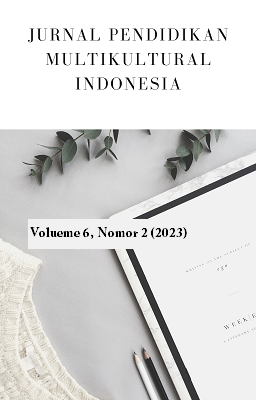Biblical Courtship and Spiritual Entities: An Exegesis of Philippians 2:3-4
DOI:
https://doi.org/10.23887/jpmu.v6i2.64913Keywords:
Christian Mysticism, Spiritual Entities, Philippians 2:3-4Abstract
The relationship between biblical courtship and spiritual entities is multifaceted and interconnected. In Christian courtship, this means being mindful of the other person's needs and desires and working together to build a relationship that is centered on mutual respect and support. The focus of this paper is to analyze Philippians 2:3-4 and examine the relationship between biblical courtship and spiritual entities. This research uses a descriptive method. Data collection in this research as primary data uses document analysis and also supported by secondary data from previous research. Data analysis process is through classifications, interpretation, compare the data, and analyze the context and meaning. The result found exegesis of Philippians 2:3-4 provides valuable guidance for Christian courtship by embracing humility, selflessness and spiritual practices to cultivate the qualities necessary for a healthy and loving relationship with another person. Biblical courtship would prioritize empathy, compassion, communication, practicing forgiveness, seeking to understand and meet the needs of one's partner. Spiritual entities provide guidance and tools for individuals to cultivate a deeper relationship with God and their partners by cultivating a deep and abiding relationship with God and prioritizing spiritual disciplines such as prayer, Bible study and worship. By incorporating these practices and principles into courtship, couples can build a strong foundation for a lifelong, Christ-centered relationship. In conclusion, biblical courtship should be grounded in a biblical worldview with individuals seeking to align their values and priorities with those of Christ.
References
Anacin, C. G. (2015). Syncretism in rituals and performance in a culturally pluralistic society in the Philippines. The Social Science Journal, 52(1), 40–45. https://doi.org/10.1016/j.soscij.2014.08.005. DOI: https://doi.org/10.1016/j.soscij.2014.08.005
Ang, A. V., & Montiel, C. J. (2019). Understanding spirit possession in the Philippines: a social representations approach. Mental Health, Religion & Culture, 22(7), 738–753. https://doi.org/10.1080/13674676.2019.1646232. DOI: https://doi.org/10.1080/13674676.2019.1646232
Asuncion, R. E. (2022). Cultural Mapping Of The Island Province Of Marinduque, Philippines: Basis For Arts Conservancy And Humanities Indigenization In Education. International Journal of Arts, Sciences and Education, 3(4), 85–111. http://www.mail.ijase.org/index.php/ijase/article/view/197.
Barfoot Christian, E. (2014). The Courting of Willie Morris: Ole Miss’ Writing Rebel. Media History Monographs, 17(1).
Baring, R. (2018). Emerging transitions in the meaning of religious constructs: The case of the Philippines. Religions, 9(12), 387. https://doi.org/10.3390/rel9120387. DOI: https://doi.org/10.3390/rel9120387
Bulloch, H. C. (2016). Fetal Personhood in the Christian Philippines The View from a visayan island. Philippine Studies Historical & Ethnographic Viewpoints, 195–222. https://www.jstor.org/stable/26621958. DOI: https://doi.org/10.1353/phs.2016.0026
Castillo, F. A. D. (2015). Christianization of the Philippines. Mission Studies: Journal of the International Association for Mission Studies, 32(1). https://doi.org/10.1163/15733831-12341379.
Cornelio, J., & Aldama, P. K. (2021). Because We Are Christian and Filipino: Christianity and the Death Penalty in the Philippines. Social Sciences and Missions, 34(3), 310–334. https://brill.com/view/journals/ssm/34/3-4/article-p310_4.xml. DOI: https://doi.org/10.1163/18748945-bja10036
Cornelio, J., & Claudio, L. E. (2022). Waiting for “God’s Best”: Love and Sex in Evangelical Christianity in the Philippines. The Journal of Religion and Popular Culture, 34(2), 127–141. https://doi.org/10.3138/jrpc.2021-0007. DOI: https://doi.org/10.3138/jrpc.2021-0007
D Blanco, J. (2019). A Mexican Princess in the Tagalog Sultan’s court: Floripes of the Doce Pares and the Transpacific Efflorescence of Colonial Philippine Romance and Theater. UNITAS, 92(1), 6–42. https://doi.org/10.31944/20199201.02. DOI: https://doi.org/10.31944/20199201.02
Del Castillo, F. A. (2015). Christianization of the Philippines: revisiting the contributions of baroque churches and religious art. Mission Studies, 32(1), 47–65. https://brill.com/view/journals/mist/32/1/article-p47_4.xml. DOI: https://doi.org/10.1163/15733831-12341379
Flores, R. (2016). Wrestling with God: Stories of Initiation in the Old Testament and Some Asian Parallels. Orientis Aura: Macau Perspectives in Religious Studies, 1, 65–76. https://journals.usj.edu.mo/index.php/orientisaura/article/view/7.
Fluckiger, S. J. (2020). Power, Control, and Marriage: The Catholic Utilization of Indigenous Wives in Early Colonial Philippines. TALA: An Online Journal of History, 3(1). http://talakasaysayan.org/index.php/talakasaysayan/article/view/36.
Garfinkel, Y. (2018). The evolution of human dance: Courtship, rites of passage, trance, calendrical ceremonies and the professional dancer. Cambridge Archaeological Journal, 28(2), 283–298. https://doi.org/10.1017/S0959774317000865. DOI: https://doi.org/10.1017/S0959774317000865
Goosen, H., & Peppler, C. (2015). Perceiving God’s voice: divine guidance for everyday believers. Conspectus: The Journal of the South African Theological Seminary, 19(3), 2–25. https://hdl.handle.net/10520/EJC170482.
Harris, J. (2005). Boy Meets Girl: Say Hello to Courtship. Multnomah Publishers.
Hwang, J. K. (2016). Storytelling and spiritual formation according to the Apostle Paul. Journal of Spiritual Formation and Soul Care, 9(1), 35–53. https://doi.org/10.1177/193979091600900104. DOI: https://doi.org/10.1177/193979091600900104
Irby, C. A. (2013). “We didn’t call it dating”: The disrupted landscape of relationship advice for evangelical Protestant youth. Critical Research on Religion, 1(2), 177–194. https://doi.org/10.1177/2050303213490041. DOI: https://doi.org/10.1177/2050303213490041
Keown, M. (2013). The Christ-Pattern for Social Relationships: Jesus as Exemplar in Philippians and Other Pauline Epistles. In Paul and His Social Relations, 301–331. https://brill.com/downloadpdf/book/edcoll/9789004244221/B9789004244221_012.pdf. DOI: https://doi.org/10.1163/9789004244221_012
Ludy, E and Ludy, L. (2009). When God Writes Your Love Story. Multnomah Publishers.
Moon, S., & Reger, J. (2014). You are not your own”: Rape, sexual assault, and consent in Evangelical Christian dating books. Journal of Integrated Social Sciences, 4(1), 55–74. https://www.jiss.org/documents/volume_4/issue_1/JISS 2014 4(1) 55-74 Christian Dating Books.pdf.
Nadeau, K. (2015). A Postscript—Changing Configurations of Gender and Family in the Philippines: Does Liberation Theology Provide a Cultural Framework for the Study of the Family? Budhi: A Journal of Ideas and Culture, 19(1), 42. https://scholarworks.lib.csusb.edu/cgi/viewcontent.cgi?article=1001&context=anthro-publications. DOI: https://doi.org/10.13185/BU2015.19102
Nhat Hanh, T. (2013). The Art of Communicating. Harper One.
Parker, L., Hoon, C. Y., & Raihani. (2014). Young people’s attitudes towards inter-ethnic and inter-religious socializing, courtship and marriage in Indonesia. South East Asia Research, 22(4), 467–486. https://doi.org/10.5367/sear.2014.0230. DOI: https://doi.org/10.5367/sear.2014.0230
Pype, K. (2016). Blackberry girls and Jesus’s brides: Pentecostal-Charismatic Christianity and the (im-) moralization of urban femininities in contemporary Kinshasa. Journal of Religion in Africa, 46(4), 390–416. https://brill.com/view/journals/jra/46/4/article-p390_3.xml. DOI: https://doi.org/10.1163/15700666-12341106
Ragandang III, P. C. (2018). Philippines: A Review of the Traditional Conflict Resolution Practices Among Indigenous Cultural Communities. Conflict Studies Quarterly, 23. http://www.csq.ro/wp-content/uploads/Primitivo-C.-RAGANDANG-III.pdf. DOI: https://doi.org/10.24193/csq.23.4
Reyes, M. E. S., Ballesteros, K. C. A., Bandol, P. A. A., & Jimenez, K. A. H. Malangen, S. D. R. (2019). Religiosity, Gender Role Beliefs, and Attitudes Toward Lesbians and Gays in the Philippines. North American Journal of Psychology, 21(3). https://www.academia.edu/download/60711302/ReyesReligiosityLG_559-57220190926-91685-1cilwf4.pdf.
Richie, C. (2017). Marriage: Patriarchal, sacramental, or covenantal. Priscilla Papers, 31(3), 16–22. https://www.academia.edu/download/55674636/v31n3p3.pdf.
Rogerson, C. M. (2017). Creative industries and urban tourism: South African perspectives. In Urban Tourism in the Developing World, 167–184. https://www.taylorfrancis.com/chapters/edit/10.4324/9781351300483-10/creative-industries-urban-tourism-south-african-perspectives-christian-rogerson. DOI: https://doi.org/10.4324/9781351300483-10
Simanjuntak, J. M. (2021). The Impact of Principal Leadership on The Effectiveness of Learning in Christian Senior High School in Bandung, Indonesia. Kelola: Jurnal Manajemen Pendidikan, 8(1), 11–21. https://doi.org/10.24246/j.jk.2021.v8.i1.p11-21. DOI: https://doi.org/10.24246/j.jk.2021.v8.i1.p11-21
Stallsmith, G. (2021). Protestant Congregational Song in the Philippines: Localization through Translation and Hybridization. Religions, 12(9), 708. https://doi.org/10.3390/rel12090708. DOI: https://doi.org/10.3390/rel12090708
Tangen, K. I. (2018). Leadership as Participation in Christ: Paul’s Theology of Leadership in the Letter to the Philippians. Journal of Biblical Perspectives in Leadership, 8(1), 276–290. .https://www.regent.edu/acad/global/publications/jbpl/vol8no1/Vol8Iss1_JBPL_22_Tangen.pdf.
Tounsel, T. N. (2018). WaitingForBoaz: Expressions of Romantic Aspiration and Black Christian Femininities on Social Media. Journal of Media and Religion, 17(3–4), 91–105. https://doi.org/10.1080/15348423.2019.1595843. DOI: https://doi.org/10.1080/15348423.2019.1595843
Vander, T. (2017). Biblical patriarchy in doctrine and practice: An analysis of evangelical Christian homeschooling. Intermountain West Journal of Religious Studies, 8(1), 57–83. https://digitalcommons.usu.edu/imwjournal/vol8/iss1/4.
Downloads
Published
How to Cite
Issue
Section
License
Copyright (c) 2023 Moses Adeleke Adeoye

This work is licensed under a Creative Commons Attribution-ShareAlike 4.0 International License.










